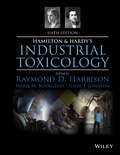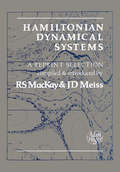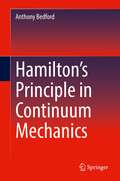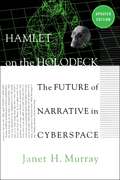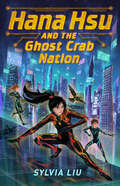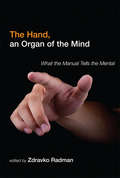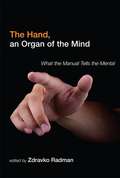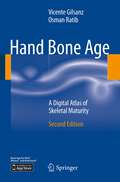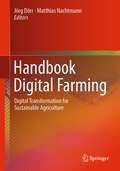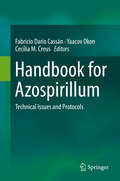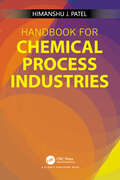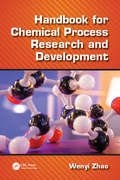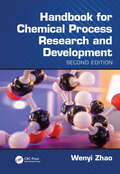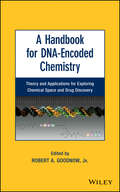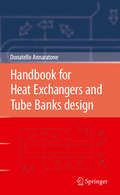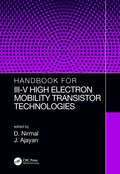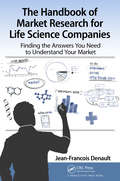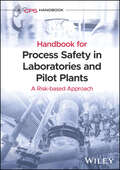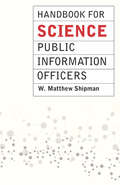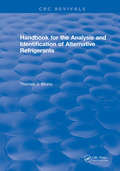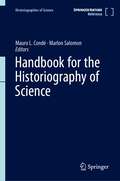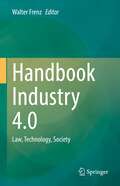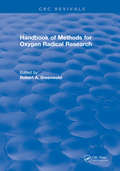- Table View
- List View
Hamilton and Hardy's Industrial Toxicology
by Raymond D. Harbison Marie M. Bourgeois Giffe T. JohnsonProviding a concise, yet comprehensive, reference on all aspects of industrial exposures and toxicants; this book aids toxicologists, industrial hygienists, and occupational physicians to investigate workplace health problems. • Updates and expands coverage with new chapters covering regulatory toxicology, toxicity testing, physical hazards, high production volume (HPV) chemicals, and workplace drug use • Includes information on occupational and environmental sources of exposure, mammalian toxicology, industrial hygiene, medical management and ecotoxicology • Retains a succinct chapter format that has become the hallmark for the previous editions • Distils a vast amount of information into one resource for both academics and professionals
Hamiltonian Dynamical Systems: A REPRINT SELECTION
by R S MacKay; J D MeissClassical mechanics is a subject that is teeming with life. However, most of the interesting results are scattered around in the specialist literature, which means that potential readers may be somewhat discouraged by the effort required to obtain them. Addressing this situation, Hamiltonian Dynamical Systems includes some of the most significant papers in Hamiltonian dynamics published during the last 60 years. The book covers bifurcation of periodic orbits, the break-up of invariant tori, chaotic behavior in hyperbolic systems, and the intricacies of real systems that contain coexisting order and chaos. It begins with an introductory survey of the subjects to help readers appreciate the underlying themes that unite an apparently diverse collection of articles. The book concludes with a selection of papers on applications, including in celestial mechanics, plasma physics, chemistry, accelerator physics, fluid mechanics, and solid state mechanics, and contains an extensive bibliography. The book provides a worthy introduction to the subject for anyone with an undergraduate background in physics or mathematics, and an indispensable reference work for researchers and graduate students interested in any aspect of classical mechanics.
Hamiltonian Mechanics of Gauge Systems
by Lev V. Prokhorov Sergei V. ShabanovThis highly acclaimed series of monographs provides introductory accounts of specialized topics in mathematical physics for graduate students and research workers. The monographs in this series are of outstanding scholarship and are written by those at the very frontiers of research, Subject areas covered include cosmology, astrophysics, relativity theory, particle physics, quantum theory, nuclear physics, statistical mechanics, condensed matter physics, plasma physics, and the theory of chaos.
Hamilton’s Principle in Continuum Mechanics
by Anthony BedfordThis revised, updated edition provides a comprehensive and rigorous description of the application of Hamilton’s principle to continuous media. To introduce terminology and initial concepts, it begins with what is called the first problem of the calculus of variations. For both historical and pedagogical reasons, it first discusses the application of the principle to systems of particles, including conservative and non-conservative systems and systems with constraints. The foundations of mechanics of continua are introduced in the context of inner product spaces. With this basis, the application of Hamilton’s principle to the classical theories of fluid and solid mechanics are covered. Then recent developments are described, including materials with microstructure, mixtures, and continua with singular surfaces.
Hamlet on the Holodeck
by Janet H. MurrayStories define how we think, the way we play, and the way we understand our lives. And just as Gutenberg made possible the stories that ushered in the Modem Era, so is the computer having a profound effect on the stories of the late 20th century. Today we are confronting the limits of books themselves -- anticipating the end of storytelling as we know it -- even as we witness the advent of a brave new world of cyberdramas. Computer technology of the late twentieth century is astonishing, thrilling, and strange, and no one is better qualified than Janet Murray to offer a breathtaking tour of how it is reshaping the stories we live by.Can we imagine a world in which Homer's Iyre and Gutenberg's press have given way to virtual reality environments like the Star Trek® holodeck? Murray sees the harbingers of such a world in the fiction of Borges and Calvino, movies like Groundhog Day, and the videogames and Web sites of the 1990s. Where is our map for this new frontier, and what can we hope to find in it? What will it be like to step into our own stories for the first time, to change our vantage point at will, to construct our own worlds or change the outcome of a compelling adventure, be it a murder mystery or a torrid romance? Taking up where Marshall McLuhan left off, Murray offers profound and provocative answers to these and other questions.She discusses the unique properties and pleasures of digital environments and connects them with the traditional satisfactions of narrative. She analyzes the state of "immersion," of participating in a text to such an extent that you literally get lost in a story and obliterate the outside world from your awareness. She dissects the titillating effect of cyber-narratives in which stories never climax and never end, because everything is morphable, and there are always infinite possibilities for the next scene. And she introduces us to enchanted landscapes populated by witty automated characters and inventive role-playing interactors, who together make up a new kind of commedia dell'arte. Equal parts daydream and how-to, Hamlet on the Holodeck is a brilliant blend of imagination and techno-wizardry that will provoke readers and guide writers for years to come.
Hana Hsu and the Ghost Crab Nation
by Sylvia Liu&“A refreshing, imaginative take on a cyberpunk future, filled with wickedly cool technology and unraveling intrigue!&” –Xiran Jay Zhao, #1 New York Times bestselling author of Iron Widow and Zachary Ying and the Dragon Emperor Perfect for fans of Dragon Pearl by Yoon Ha Lee, this thrilling, cinematic sci-fi novel follows Hana Hsu&’s mission to save herself—and her friends—from a dangerous plot to control their minds.Hana Hsu can&’t wait to be meshed. If she can beat out half her classmates at Start-Up, a tech school for the city&’s most talented twelve-year-olds, she&’ll be meshed to the multiweb through a neural implant like her mom and sister. But the competition is fierce, and when her passion for tinkering with bots gets her mixed up with dangerous junkyard rebels, she knows her future in the program is at risk. Even scarier, she starts to notice that something&’s not right at Start-Up—some of her friends are getting sick, and no matter what she does, her tech never seems to work right. With an ominous warning from her grandmother about being meshed, Hana begins to wonder if getting the implant early is really a good idea. Desperate to figure out what&’s going on, Hana and her friends find themselves spying on one of the most powerful corporations in the country—and the answers about the mystery at Start-Up could be closer to home than Hana&’s willing to accept. Will she be able to save her friends—and herself— from a conspiracy that threatens everything she knows?
The Hand, an Organ of the Mind: What the Manual Tells the Mental
by Zdravko RadmanTheoretical and empirical accounts of the interconnectedness between the manual and the mental suggest that the hand can be understood as a cognitive instrument. Cartesian-inspired dualism enforces a theoretical distinction between the motor and the cognitive and locates the mental exclusively in the head. This collection, focusing on the hand, challenges this dichotomy, offering theoretical and empirical perspectives on the interconnectedness and interdependence of the manual and mental. The contributors explore the possibility that the hand, far from being the merely mechanical executor of preconceived mental plans, possesses its own know-how, enabling "enhanded" beings to navigate the natural, social, and cultural world without engaging propositional thought, consciousness, and deliberation.The contributors consider not only broad philosophical questions—ranging from the nature of embodiment, enaction, and the extended mind to the phenomenology of agency—but also such specific issues as touching, grasping, gesturing, sociality, and simulation. They show that the capacities of the hand include perception (on its own and in association with other modalities), action, (extended) cognition, social interaction, and communication. Taken together, their accounts offer a handbook of cutting-edge research exploring the ways that the manual shapes and reshapes the mental and creates conditions for embodied agents to act in the world.ContributorsMatteo Baccarini, Andrew J. Bremner, Massimiliano L. Cappuccio, Andy Clark, Jonathan Cole, Dorothy Cowie, Natalie Depraz, Rosalyn Driscoll, Harry Farmer, Shaun Gallagher, Nicholas P. Holmes, Daniel D. Hutto, Angelo Maravita, Filip Mattens, Richard Menary, Jesse J. Prinz, Zdravko Radman, Matthew Ratcliffe, Etiennne B. Roesch, Stephen V. Shepherd, Susan A.J. Stuart, Manos Tsakiris, Michael Wheeler
The Hand, an Organ of the Mind
by Zdravko RadmanCartesian-inspired dualism enforces a theoretical distinction between the motor and the cognitive and locates the mental exclusively in the head. This collection, focusing on the hand, challenges this dichotomy, offering theoretical and empirical perspectives on the interconnectedness and interdependence of the manual and mental. The contributors explore the possibility that the hand, far from being the merely mechanical executor of preconceived mental plans, possesses its own know-how, enabling "enhanded" beings to navigate the natural, social, and cultural world without engaging propositional thought, consciousness, and deliberation. The contributors consider not only broad philosophical questions -- ranging from the nature of embodiment, enaction, and the extended mind to the phenomenology of agency -- but also such specific issues as touching, grasping, gesturing, sociality, and simulation. They show that the capacities of the hand include perception (on its own and in association with other modalities), action, (extended) cognition, social interaction, and communication. Taken together, their accounts offer a handbook of cutting-edge research exploring the ways that the manual shapes and reshapes the mental and creates conditions for embodied agents to act in the world.ContributorsMatteo Baccarini, Andrew J. Bremner, Massimiliano L. Cappuccio, Andy Clark, Jonathan Cole, Dorothy Cowie, Natalie Depraz, Rosalyn Driscoll, Harry Farmer, Shaun Gallagher, Nicholas P. Holmes, Daniel D. Hutto, Angelo Maravita, Filip Mattens, Richard Menary, Jesse J. Prinz, Zdravko Radman, Matthew Ratcliffe, Etiennne B. Roesch, Stephen V. Shepherd, Susan A. J. Stuart, Manos Tsakiris, Michael Wheeler
Hand Bone Age
by Vicente Gilsanz Osman RatibIn the past, determination of bone maturity relied on visual evaluation of skeletal development in the hand and wrist, most commonly using the Greulich and Pyle atlas. The Gilsanz and Ratib digital atlas takes advantage of digital imaging and provides a more effective and objective approach to assessment of skeletal maturity. The atlas integrates the key morphological features of ossification in the bones of the hand and wrist and provides idealized, sex- and age-specific images of skeletal development New to this revised second edition is a description and user manual for Bone Age for iPad®, iPhone® and iPod touch®, which can be purchased and used separately from this book. The App can be easily employed to calculate the deviation of the patient's age from the normal range and to predict a possible growth delay. This easy-to-use atlas and the related App will be invaluable for radiologists, endocrinologists, and pediatricians and also relevant to forensic physicians.
Handbook Digital Farming: Digital Transformation for Sustainable Agriculture
by Jörg Dörr Matthias NachtmannThe Handbook Digital Farming sheds light on the technological, economic, social, and legal perspectives of the digital transformation. The authors of the individual chapters explain the state of the art and the development of business models, enabling readers to draw conclusions for their own organizations. They also provide an outlook on trends, and further developments. The handbook provides technological facts from renowned experts and concrete business examples from experienced companies and start-ups. It is aimed at farmers, farm and business managers, decision-makers and developers of digital tools and strategies in the agri-food sector, as well as scientists and students. The handbook provides insights to the discussion of what contribution digital farming can make to the implementation of Green Deal, Farm to Fork and the new Common Agricultural Policy.
Handbook for Azospirillum
by Fabricio Dario Cassán Yaacov Okon Cecilia M. CreusThe functional analysis of plant-microbe interactions has re-emerged in the past 10 years due to spectacular advances in integrative study models. This book summarizes basic and technical information related to the plant growth promoting rhizobacteria (PGPR) belonging to the genus Azospirillum, considered to be one of the most representative PGPR last 40 years. We include exhaustive information about the general microbiology of genus Azospirillum, their identification strategies; the evaluation of plant growth promoting mechanisms, inoculants technology and agronomic use of these bacteria and some special references to the genetic technology and use.
Handbook for Chemical Process Industries
by Himanshu J PatelChemical processing industry plays a pivotal role in the economy of a country, as chemicals are required in every sphere of our lives. This book covers chemical processing of dyes, pigments, drugs and pharmaceutical products, fermented products, agrochemicals, explosives, polymers, Period II and III chemicals, chemicals, sugar, coatings, starches, soaps and detergents, paper, pulp, glass, and cement. It includes sources of natural materials, collection process, purification, and extraction of different chemicals from natural materials like petroleum, coal and ores from the Earth. It includes manufacturing details of C1 to C4 and aromatic compounds obtained from natural materials. The book covers both traditional and modern sectors of the chemical processing industry. It provides knowledge on the properties of the chemical and manufacturing process (such as raw materials, chemical reactions, quantitative requirement, flow sheet diagram, procedure) and its uses. The book is based on the author's expertise and has been developed with an awareness of the quantitative requirement for manufacturing chemicals. Data has been collected from industry, thus it will be useful to industry personnel, research groups, academicians and institutional organizations.
Handbook for Chemical Process Research and Development
by Wenyi ZhaoThe Handbook for Chemical Process Research and Development focuses on developing processes for chemical and pharmaceutical industries. Forty years ago there were few process research and development activities in the pharmaceutical industry, partially due to the simplicity of the drug molecules. However, with the increasing structural complexity, especially the introduction of chiral centers into the drug molecules and strict regulations set by the EMA and FDA, process R&D has become one of the critical departments for pharmaceutical companies. This book assists with the key responsibility of process chemists to develop chemical processes for manufacturing pharmaceutical intermediates and final drug substances for clinical studies and commercial production.
Handbook for Chemical Process Research and Development, Second Edition
by Wenyi ZhaoThis fully updated second edition reflects the significant changes in process chemistry since the first edition and includes more common process issues such as safety, cost, robustness, and environmental impact. Some areas have made notable progress such as process safety, stereochemistry, new reagents and reagent surrogates. Forty years ago there were few process research and development activities in the pharmaceutical industry, partly due to the simplicity of drug molecules. With increasing structural complexity especially the introduction of chiral centers into drug molecules and stricter regulations, process R&D has become one of the critical departments for pharmaceutical companies. Features: This unique volume now in its second edition is designed to provide readers with an unprecedented strategy and approach which will help chemists and graduate students develop chemical processes in an efficient manner. Promotes an industrial mindset concerning safety and commercial viability when developing methods. The author discusses development strategies with case studies and experimental procedures. Focuses on mechanism-guided process development which provides readers with practical strategies and approaches. Addresses more common process issues such as safety, cost, robustness, and environmental impact. This book provides a new direction for scientists, researchers, and students in materials science and polymer chemistry who seek to better understand the chemistry behind conducting polymers and improve their performance for use in advanced energy applications.
A Handbook for DNA-Encoded Chemistry
by Robert A. Goodnow Jr.This book comprehensively describes the development and practice of DNA-encoded library synthesis technology. Together, the chapters detail an approach to drug discovery that offers an attractive addition to the portfolio of existing hit generation technologies such as high-throughput screening, structure-based drug discovery and fragment-based screening. The book:Provides a valuable guide for understanding and applying DNA-encoded combinatorial chemistry Helps chemists generate and screen novel chemical libraries of large size and quality Bridges interdisciplinary areas of DNA-encoded combinatorial chemistry - synthetic and analytical chemistry, molecular biology, informatics, and biochemistry Shows medicinal and pharmaceutical chemists how to efficiently broaden available "chemical space" for drug discovery Provides expert and up-to-date summary of reported literature for DNA-encoded and DNA-directed chemistry technology and methods
Handbook for Heat Exchangers and Tube Banks design
by Donatello AnnaratoneWhen a heating fluid transfers heat to a heated fluid through a wall, if the fluids are in parallel flow or counter flow it is possible to compute exactly both the transferred heat and the temperatures of the fluids via well-known equations. This holds true both for design and verification computation. However, the motion of the fluids is never in parallel flow or counter flow in heat exchangers and in tube banks. Instead, it is rather complex and consists of a combination of various cross flows. Hence, a precise design of the above components requires, on a case-by-case basis, the availability of the value of certain crucial factors or of corrective factors so as to make it possible to use the equations relative to parallel flow or counter flow. This handbook contains the introduction to the problem, its design criteria, and about 70 tables for the exact design and verification computation. It also indicates how to proceed in the case of cross flow.
Handbook for III-V High Electron Mobility Transistor Technologies
by D. Nirmal J. AjayanThis book focusses on III-V high electron mobility transistors (HEMTs) including basic physics, material used, fabrications details, modeling, simulation, and other important aspects. It initiates by describing principle of operation, material systems and material technologies followed by description of the structure, I-V characteristics, modeling of DC and RF parameters of AlGaN/GaN HEMTs. The book also provides information about source/drain engineering, gate engineering and channel engineering techniques used to improve the DC-RF and breakdown performance of HEMTs. Finally, the book also highlights the importance of metal oxide semiconductor high electron mobility transistors (MOS-HEMT). Key Features Combines III-As/P/N HEMTs with reliability and current status in single volume Includes AC/DC modelling and (sub)millimeter wave devices with reliability analysis Covers all theoretical and experimental aspects of HEMTs Discusses AlGaN/GaN transistors Presents DC, RF and breakdown characteristics of HEMTs on various material systems using graphs and plots
The Handbook for Market Research for Life Sciences Companies: Finding the Answers You Need to Understand Your Market
by Jean-Francois DenaultAs innovation moves from the lab to the market, a new research phase begins for the entrepreneur: the market research phase. Inspired by a new technology that can change the world, critical questions need to be addressed. Is there a market for my innovation? Who are my clients? What do they need? Is my innovation filling that gap in the market? Who are my competitors? How are they approaching the market? If these questions are unaswered, entrepreneurs meet potential investors or partners with only a basic understanding of their market. The objective of this book is to fill this gap. It is a practical manual that gives entrepreneurs real-world advice and tools to build a solid market model. The book provides tips, models and tools entrepreneurs can use to collect, interpret and present their market and integrate it into their business plan. What the entrepreneur learns in this book will help him throughout his journey. After going over the market research process, he will learn how to design and use a number of market research tools, and how to adapt them in a life science context. From building a web survey to preparing interviews to doing your own secondary research, this handbook will help him gain a comprehensive understanding of how to perform his own market research activities and how to analyze his data. Finally, a number of frameworks (such as the TAM-SAM-SOM as well as the KANO Model) are described so that he can efficiently share what he has learned, using models that simply yet effectively shares findings.
Handbook for Process Safety in Laboratories and Pilot Plants: A Risk-based Approach
by CCPS (Center for Chemical Process Safety)Handbook for Process Safety in Laboratories and Pilot Plants Effectively manage physical and chemical risks in your laboratory or pilot plant In Handbook for Process Safety in Laboratories and Pilot Plants: A Risk-based Approach, the Center for Chemical Process Safety delivers a comprehensive and authoritative presentation of process safety procedures and methods for use in laboratories and pilot plants (LAPPs). Of the four broad hazard categories — chemical, physical, biological, and ionizing radiation — this book focuses on the two most common: chemical and physical hazards. It addresses the storage and handling of the hazardous materials associated with activities commonly performed in LAPPs and presents many of the physical and chemical analytical techniques used to verify and validate the efficacy of safety management systems. This book will present tools and techniques for effectively managing the risks in any laboratory or pilot plant using engineered and administrative controls, as well as the CCPS Risk Based Process Safety (RBPS) Management Systems. Readers will also find: A thorough introduction to process safety Comprehensive explorations of understanding hazards and risks, as well as managing risk with engineered controls, administrative controls, and RBPS Management Systems Practical discussions of how to learn from the experiences of your own LAPP and others Detailed case reports and examples, as well as practical tools, control banding strategies, and glass equipment design Perfect for any LAPP staff member working with or managing hazardous materials, Handbook for Process Safety in Laboratories and Pilot Plants: A Risk-based Approach will also benefit LAPP engineering and scientific professionals, LAPP technical support staff, and LAPP managers. The Center for Chemical Process Safety is a world leader in developing and distributing information on process safety management and technology. Since 1985, CCPS has published over 100 books in its process safety guidelines and concept series, 33 training modules as part of its Safety in Chemical Engineering Education series, and over 220 online offerings.
Handbook for Science Public Information Officers
by W. Matthew SimpsonWhether sharing a spectacular shot from a deep-space probe, announcing a development in genetic engineering, or crafting an easy-to-reference list of cancer risk factors, science public information officers, or PIOs, serve as scientific liaisons, connecting academic, nonprofit, government, and other research organizations with the public. And as traditional media outlets cut back on their science coverage, PIOs are becoming a vital source for science news. W. Matthew Shipman's Handbook for Science Public Information Officers covers all aspects of communication strategy and tactics for members of this growing specialty. It includes how to pitch a story, how to train researchers to navigate interviews, how to use social media effectively, and how to respond to a crisis. The handbook offers a wealth of practical advice while teaching science PIOs how to think critically about what they do and how they do it, so that they will be prepared to take advantage of any situation, rather than being overwhelmed by it. For all science communicators--whether they're starting their careers, crossing over from journalism or the research community, or professional communicators looking to hone their PIO skills--Shipman's Handbook for Science Public Information Officers will become their go-to reference.
Handbook for Shell Collectors,Revised Edition
by Walter Freeman WebbDescriptions of over 2000 marine species.
Handbook for the Analysis and Identification of Alternative Refrigerants
by Thomas J. BrunoMany laboratories are engaged in research on the development of new fluids for use as refrigerants to replace the fully halogenated materials that are believed to contribute to atmospheric ozone depletion. An integral part of this effort is the chemical analysis of new fluids that are synthesized, prepared, and tested. This comprehensive book, which is divided into two parts, fills an important need in this vital chemical analysis protocol. The first part reviews the major chemical analysis methods that have been developed and used at NIST and in other laboratories. This review covers spectroscopic, chromatographic, and "wet" analytical methods, with treatment divided by qualitative identification, qualitative determinations, and chemical reaction screening. The second part contains a compilation of analytical information of the new fluids and their products. Physical properties, mass spectra, infrared spectra, ultraviolet spectra, nuclear magnetic resonance spectra, and gas chromatographic retention data are provided for each fluid or product.
Handbook for the Historiography of Science (Historiographies of Science)
by Mauro L. Condé Marlon SalomonThis book aims to perform a critical and broad assessment of the historiography of science produced from the late nineteenth century to the early twenty-first century. It presents its main authors, concepts, ideas, conceptions, and schools. It also analyzes the historical circumstances of the rise of the discipline history of science and the relations of the historiography of science with related areas. These chapters do not understand the historiography of science as a mere description or record of the history of science. Instead, they understand the historiography of science from the epistemological criteria and choices that guided the writing of the history of science in its different contexts. In other words, more than describing the record of the various possibilities of historiographical approaches to science, the chapters carry out an epistemological reflection to assess the bases, possibilities, scope, and limits of different historiographical conceptions, authors, and traditions that have established the writing of the history of science. This book can be conceived as a reference work not only for professional historians and philosophers but also for academics from different backgrounds who are initiating themselves in the universe of history and philosophy of science, be they scientists from different fields or young researchers from different backgrounds who want to start studying the history and philosophy of science.
Handbook Industry 4.0: Law, Technology, Society
by Walter FrenzThe handbook presents an overview of Industry 4.0 and offers solutions for important practical questions. The law and its current challenges regarding data assignment (who owns the data? / EU guidelines), data security, data protection (General Data Protection Regulation), cyberattacks, competition law (right to access vs. monopolists, permissible and prohibited exchanges of information, possible collaborations) is the point of departure. In turn, the book explores peculiarities in specific areas of Industry 4.0 (Internet of Production, mechanical engineering, artificial intelligence, electromobility, autonomous driving, traffic, medical science, construction, energy industry, etc.). The book’s closing section addresses general developments in management, the digital transformation of companies and the world of work, and ethical questions.
Handbook Methods For Oxygen Radical Research
by Robert A. GreenwaldThis volume is divided into five sections. Section I deals with preparative methodology for isolation and purification of the components of the oxy radical experimental systems use most frequently, including all three forms of SOD and several other important scavengers. Section II provides the experimenter with a choice of a dozen oxy radical generating systems which can be used for testing of scavengers or for evaluation of the effects of oxy radicals on target tissues. The reader will note that in this section, as well as in most of the rest of the volume, the orientation is primarily biochemical, biologic, and medical, rather than pure chemistry or pure physics. Nevertheless, the techniques are widely applicable to a variety of disciplines.
